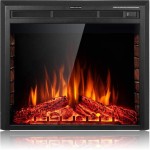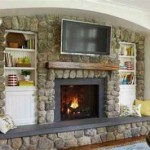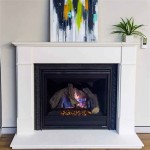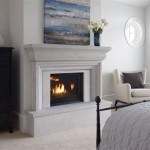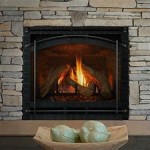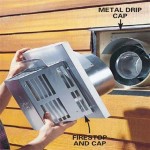Fireplace Refractory Panels: Herringbone Design
Fireplace refractory panels are essential components of a fireplace, stove, or furnace. They serve several critical functions, including protecting the firebox from extreme heat, reflecting heat back into the fire, and improving the appliance's overall efficiency. Refractory panels are typically made from materials that can withstand very high temperatures without degrading or cracking, such as ceramic fiber, firebrick, or castable refractory cement. These materials are chosen for their thermal resistance and ability to radiate heat.
The selection of refractory panels is a significant decision when constructing or repairing a fireplace. Considerations must include the type of fuel used, the size of the firebox, and the desired aesthetic. Different materials offer varying levels of thermal protection and decorative possibilities. While traditional brick is a common choice, modern ceramic fiber panels offer lighter weight and superior insulation. More recently, panels incorporating decorative patterns have gained popularity, bringing an element of style to this functional component of a fireplace. Among these decorative options, the herringbone pattern stands out as a particularly appealing and versatile choice.
This article explores the characteristics, benefits, and considerations surrounding fireplace refractory panels with a herringbone design.
Understanding Refractory Panel Functionality
Refractory panels are more than mere decorative elements within a fireplace. Their primary function centers on providing a protective barrier against the intense heat generated by the fire. Without refractory panels, the firebox walls, typically made of metal or masonry, would be directly exposed to temperatures that can exceed 1000 degrees Fahrenheit. This direct exposure can lead to rapid deterioration of the firebox structure, potentially causing cracks, warping, and eventually, structural failure. The refractory panels, therefore, act as a sacrificial layer, absorbing the brunt of the heat and protecting the underlying materials.
Beyond protection, refractory panels also contribute significantly to the efficiency of the fireplace. By reflecting heat back into the firebox, they promote more complete combustion of the fuel. This means that more of the fuel's energy is converted into heat, reducing the amount of unburned fuel that goes up the chimney as smoke. This improved combustion results in a hotter fire, a cleaner burn, and ultimately, more heat output for the same amount of fuel. This is especially important in wood-burning stoves and fireplaces where maximizing heat output is a primary goal.
Another crucial function relates to safety. By containing the fire within a defined space and preventing extreme heat from reaching the surrounding structure, refractory panels reduce the risk of fire hazards. They help to maintain a safe operating temperature for the surrounding walls and floors, minimizing the potential for accidental ignition of nearby combustible materials. Choosing the correct type and thickness of refractory panel is therefore critical to the safe operation of any fireplace or stove.
The Aesthetic Appeal of Herringbone Panels
The herringbone pattern, a classic arrangement of rectangular blocks set at right angles to each other in a zigzag fashion, has long been admired for its visual appeal. This pattern, borrowed from textiles and flooring, introduces a sense of sophistication and timelessness to any surface. When applied to fireplace refractory panels, the herringbone design elevates the firebox from a purely functional space to a visually striking focal point.
The geometric nature of the herringbone pattern creates a visually engaging texture that adds depth and dimension to the firebox. The alternating angles of the bricks or tiles catch and reflect light in different directions, creating a subtle play of light and shadow that enhances the overall aesthetic. This is in contrast to plain, flat panels which can appear monotonous and lacking in character. The herringbone pattern, even in a single color, provides visual interest and breaks up the monotony of the firebox interior.
Furthermore, the herringbone pattern is remarkably versatile and complements a wide range of architectural styles. It can look equally at home in a traditional, rustic fireplace or a modern, minimalist design. The choice of material and color can further enhance the pattern's adaptability. For example, firebrick with a natural reddish-brown hue will lend itself to a more traditional aesthetic, while a darker, more neutral color palette can create a sleek, contemporary look. Similarly, using different textures can alter the entire feel of the design, from rough-hewn brick for a rustic look to smooth, polished surfaces for a modern one.
The installation of herringbone refractory panels also allows for a degree of customization. The size and orientation of the rectangles can be adjusted to suit the specific dimensions of the firebox and the desired aesthetic. This flexibility allows homeowners to create a truly unique fireplace design that reflects their personal style and preferences.
Considerations When Choosing Herringbone Refractory Panels
While the aesthetic appeal of herringbone refractory panels is undeniable, it is crucial to consider several practical factors before making a purchase. The material, thickness, and installation method all play a vital role in ensuring the panels perform their intended functions and maintain their appearance over time.
The material of the refractory panel is paramount. Common choices include firebrick, castable refractory cement, and ceramic fiber. Firebrick is a traditional option known for its durability and heat resistance. Castable refractory cement offers greater flexibility in terms of shaping and design. Ceramic fiber panels are lightweight and provide excellent insulation. The material selection should depend on the specific requirements of the fireplace or stove, including the type of fuel burned, the operating temperature, and the desired level of insulation. For example, appliances that burn wood at high temperatures may require thicker, denser firebrick, while gas-burning fireplaces may be adequately protected by thinner ceramic fiber panels. The manufacturer's recommendations should always be consulted.
The thickness of the refractory panel is directly related to its ability to withstand heat and protect the firebox walls. Thicker panels offer greater thermal resistance, but they may also reduce the size of the firebox. The appropriate thickness will depend on the size and type of appliance. It is essential to ensure that the chosen thickness is sufficient to provide adequate protection without compromising the firebox's functionality.
Proper installation is essential for the longevity and performance of herringbone refractory panels. The panels must be securely attached to the firebox walls using a suitable adhesive or mortar. The joints between the panels should be tightly sealed to prevent heat from escaping and damaging the underlying structure. Incorrect installation can lead to premature failure of the panels, compromising their protective function and potentially creating a fire hazard. Therefore, professional installation is often recommended, especially for complex projects or when working with specialized materials.
Finally, the cost of herringbone refractory panels should be considered. Compared to plain, flat panels, those with a herringbone design may be more expensive due to the additional manufacturing steps involved in creating the pattern. Installation costs may also be higher if professional help is required. The overall cost should be weighed against the aesthetic benefits and the long-term value of protecting the fireplace.
In conclusion, fireplace refractory panels with a herringbone design offer a compelling combination of functionality and aesthetic appeal. By understanding their role in protecting the firebox, their decorative potential, and the crucial considerations surrounding material selection and installation, homeowners can make informed decisions that enhance both the safety and beauty of their fireplaces.

Superior Wre4542 42 Fireplace White Herringbone Refractory Panels Fireplaces Usa

Superior Vre4550 50 Fireplace White Herringbone Refractory Panels Fireplaces Usa

Superior Wrt3543 43 Fireplace Grey Herringbone Refractory Panels Fireplaces Usa

Superior Wre3036 36 Fireplace White Herringbone Refractory Panels Fireplaces Usa

Vre4336 36 Elec White Herringbone Refractory Panels Vre4336zenh By Hearth Mart

Superior Brt4542 42 Elec White Herringbone Refractory Panel Brt4 Fireplaces Usa

Herringbone Premium Fiber Model Fbpremh32 Fireplace Panels Liners

Superior 42 Traditional Vent Free Outdoor Firebox Vre4242 Us Fireplace

Outdoor Lifestyles Grey Herringbone Refractory Panels For Courtyard 36 Inch Gas Fireplace

Superior Fireplaces Wrt4550wh 50 Wood Burning Fireplace


